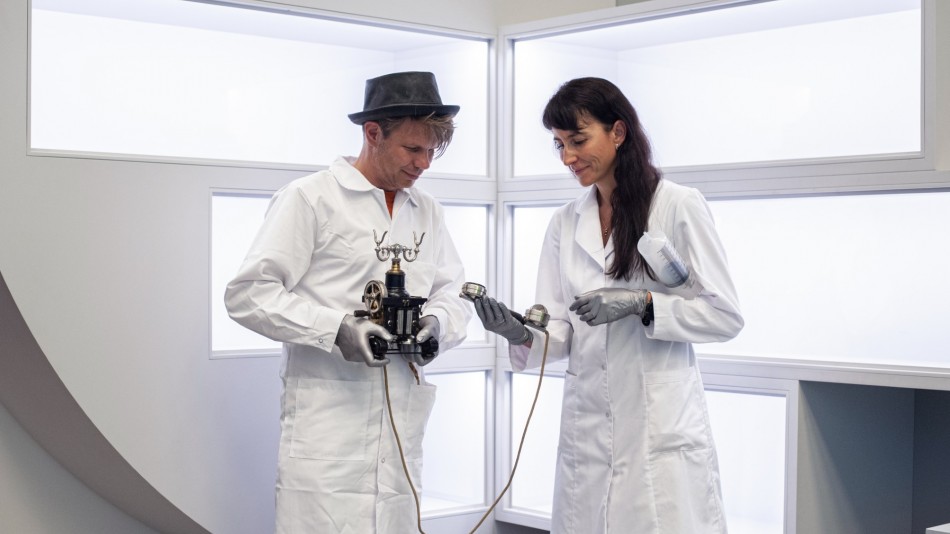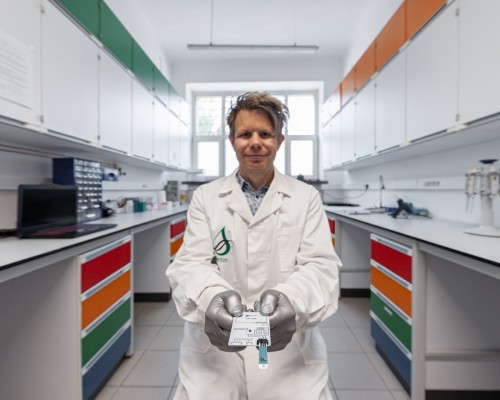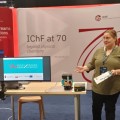One, two, three – catch CRP
Reading time: about 6 minuts

As inflammation is the body's natural immune response to disease or infection, it increases blood flow in the body and helps the body's cells to defend themselves against viruses, infections or cell damage. Fast diagnostics of inflammation is crucial for effective treatments, it is extremely important to test the levels of inflammatory biomarkers in the body. Recently, researchers from the Institute of Physical Chemistry, Polish Academy of Sciences demonstrated a novel point-of-care device to monitor levels of the C-reactive protein (CRP) that is produced in the body during inflammation. How does it work?
C-reactive protein (CRP) is a molecule is an important factor to flare-up many diseases of various aetiologies. Although CRP has been known and used for many decades to diagnose inflammation in the body, its use as a potential biomarker in the diagnosis of other disease conditions in the body is relatively new. CRP is a plasma protein produced in the liver and released into the bloodstream as a response of the immune system acting as and biomarker of inflammation and infection. Its level monitoring helps to diagnose even severe conditions like trauma, sepsis, ischemic necrosis and/or malignancies. As it is classified as an acute phase reactant, the single measurement of its level only indicates the inflammatory diseases, and blood tests need to be repeated to determine the efficacy of a specific therapy. Currently, despite the technological advances in biomedicine and medical diagnostics, techniques used to monitor CRP levels are still far from the rapid and real-time measurements.
Recently, researchers from the Institute of Physical Chemistry, Polish Academy of Sciences led by prof. Martin Jönsson-Niedziółka presented a novel diagnostics tool to measure precisely levels of the CRP. What’s more, measurements can be taken in real time, reducing analysis time and costs. The proposed solution is based on a smartphone-connected point-of-care testing (POCT) device the size of a credit card, using simple electrochemical biosensors with near-field communication technology embedded in a microfluidic device.
Unlike various biosensors that use large IgG antibodies to capture relevant inflammatory biomarkers, the proposed POCT device offers higher sensitivity and stability, as well as real-time measurements, significantly increasing the potential application in CRP diagnostics. The device equipped with the biosensor can capture and quantify CRP with the effectiveness similar to the classical and expensive ELISA tests. The measurements are performed electrochemically using a commercially available, portable potentiostat, while the CRP capture takes place on the unique electrode incorporated into the small channels of the microfluidic device. The system also uses near-field communication (NFC) technology allowing wireless data exchange between sensors and mobile devices. The results can be displayed on Android smartphones providing users with an effective way to collect and analyze electrochemical data in real time.
How does it work? The fluid sample is placed on a small plate of the microfluidic device, which is equipped with a small electrode. Through minute channels in the device, the sample is fed gradually into subsequent parts of the device along with additional solution based on the capillary transport without the need for an external pump, which enables automatic sequential flow. The key role in the demonstrated device is played by the anti-CRP nanobodies immobilized onto the electrode. Nanobodies are small antibody fragments working as an alternative to conventional antibodies used for CRP quantification. For the small size, higher degradation resistance compared to the antibodies, nanobodies obtained with the phage display method can be used in different experimental conditions achieving a high antigen binding specificity.
“To immobilize the anti-CRP nanobodies onto the electrode, the hydroxyl functional groups of the oxidized electrode were first modified to incorporate aldehyde groups through an oxidation reaction. Anti-CRP nanobodies were subsequently immobilized on the oxidized electrode through an imine bond (C═N). In that way we obtained the electrode having high specific antigen affinity.” – says dr. Suchanat Boonkaew, the first author of the presented work.
The high surface density of nanobodies on the electrode improves the sensitivity of electrochemical measurement in the range of even very low concentrations. This provides an optimal compromise between analytical accuracy in the physiologically relevant concentration range and analysis time.
Dr. Katarzyna Szot-Karpińska adds: “To produce the nanobody modified electrode, we relied on our experience in biopanning to recover novel CRP-specific nanobodies to be used as the active material in the fabricated biosensor.”
The selectivity of the proposed nanobody-based biosensor was tested in various media interfering the measurements with the presence of biologically active compounds like interleukin-6 (IL-6), fibrinogen, myoglobin, bovine serum albumin (BSA), and human serum albumin (HSA) as well as exposing the device onto different experimental conditions including temperature and humidity changes.
Prof. Martin Jönsson-Niedziółka remarks “The proposed method was applied to the detection of CRP in whole human blood obtained from anonymous donors. The experimental results showed that the NFC-based system integrated with the flow-through microfluidic device can correctly quantify CRP in clinically relevant biological samples without the need for pretreatment procedures and could therefore be used for the assessment of inflammation, infections caused by bacteria or viruses, and monitor for increased risk of heart disease”.
Sooner or later, everyone struggles with inflammation. Regardless of the aetiology, rapid and selective diagnostics that enable real-time monitoring of treatment efficacy are still far from ideal. Therefore, when fast and portable point-of-care testing devices are applied in real life, they will undoubtedly revolutionise many sectors of medical diagnostics, making life easier for many patients. The device demonstrated by researchers at the IPC PAS provides a reliable and cost-effective diagnostic solution offering user-friendly operation and rapid results in just minutes without leaving home. It also provides reproducibility in both biosensor production and CRP detection, becoming a step towards modern and personalised healthcare. The nanobody-based electrodes enable multiple analyses to be performed in real time, speeding up diagnosis and assessment of treatment efficacy, thereby enabling immediate treatment decisions and improving patient outcomes.
This research published in the ACS Sensors was supported by the National Centre for Research and Development (NCBR) through the EEA and Norway Grants (Project number: NOR/POLNOR/UPTURN/0060/2019) and by the CRP 20/026 grant offered by ICGEB and the National Science Centre Poland via a SONATA 13 grant UMO-2017/26/D/ST5/00980.
CONTACT:
Prof. Martin Jönsson-Niedziółka
Institute of Physical Chemistry, Polish Academy of Sciences
Phone: +48 22 343 3406
e-mail: martinj@ichf.edu.pl
ARTICLE:
" NFC Smartphone-Based Electrochemical Microfluidic Device Integrated with Nanobody Recognition for C-Reactive Protein”
Suchanat Boonkaew, Katarzyna Szot-Karpińska, Joanna Niedziółka-Jönsson, Ario de Marco, Martin Jönsson-Niedziółka
ACS Sens. 2024, 9, 6, 3066–307
- Author: Dr Magdalena Osial
- Contact: magdalena@osial.eu
- Photo source: Grzegorz Krzyżewski
- Date: 23.08.2024







